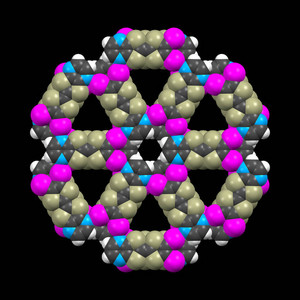Nov. 17, 2006 Research Highlight Chemistry
Organic conductors on the road to recovery
No end in sight for organic conductors that can be recycled with a simple chemical reaction
 Figure 1: A space-filling representation of the hexagonal lattice structure formed in crystals of DIPSe grown by electrochemical oxidation.
Figure 1: A space-filling representation of the hexagonal lattice structure formed in crystals of DIPSe grown by electrochemical oxidation.
When packed into ordered arrangements in a crystal lattice, some small organic molecules can show metallic conductivity of electricity. Organic conductors are often comprised of molecules that have a delocalized system of π-electrons. These flat molecules stack on top of one another in a crystal resulting in significant overlap between their electron clouds and conduction can occur through these one-dimensional columns.
Crystals of organic conductors are often grown under conditions where electrons are removed from some of the neutral molecules to generate positive (cationic) species. This means that positive ‘holes’ are shared between adjacent molecules in the stacks and electrical conduction is possible. Controlling the organization of an organic conductor in a crystal may make it possible to fine-tune its properties.
Now, Tatsuro Imakubo from RIKEN’s Frontier Research System in Wako and co-workers, have tailored the solid-state packing of an organic conductor by using the strong and directional interaction between iodine and nitrogen atoms, the so-called ‘iodine bond’. A common structural motif found in organic conductors comprises a carbon framework containing four selenium atoms and is called tetraselenafulvalene. Imakubo modified this compound by joining two iodine atoms to one end and a ring containing two nitrogen atoms to the other to form a substance referred to by the acronym ‘DIPSe’.
X-ray analysis of crystals grown from DIPSe by electrochemical oxidation (in which electrons are removed) revealed that the molecules form a hexagonal lattice and stack together to form channels running through the structure. The results are reported in the Journal of Materials Chemistry 1. A range of structures were prepared in which the anionic (negatively-charged) counterpart of the cation was varied, and all of them displayed metallic conductivity at room temperature.
Significantly, Imakubo and co-workers were able to recover the neutral DIPSe molecules by simply reacting the crystals with water. This is unusual because cation molecules contain unpaired electrons and are very reactive species, known as radicals. Although stable in the crystal form, often a complex mixture of decomposed products is obtained if treated with water.
The unique channel structure of this organic conductor is thought to play an important role. “The characteristic channels, which allow water molecules to access the cation radicals deep in the crystal, are essential for the smooth progress of the recovery process,” points out Imakubo. “Our initial results have provided the first example of the recyclability of organic conductors and it will stimulate new research in to the utilization of them.”
References
- 1. Imakubo, T., Kibune, M., Yoshino, H., Shirahata, T. & Yoza, K. Hexagonal supramolecular organic conductors based on diiodo(pyrazino)tetraselenafulvalene: high yield recovery of the neutral π-donor by a simple chemical reaction. Journal of Materials Chemistry 16, 4110–4116 (2006). doi: 10.1039/B611010J
